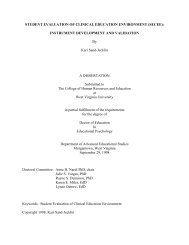The Use of Native Plants for Revegetation along West Virginia ...
The Use of Native Plants for Revegetation along West Virginia ...
The Use of Native Plants for Revegetation along West Virginia ...
Create successful ePaper yourself
Turn your PDF publications into a flip-book with our unique Google optimized e-Paper software.
cost more than $5.00 per pound <strong>of</strong> pure live seed (Ernst Conservation Seed, 2005). <strong>The</strong> harsh<br />
environment found on roadsides tends to inhibit the successful establishment <strong>of</strong> the<br />
competitively disadvantaged natives. Roadsides are typically seeded with aggressive species at<br />
high rates. Once established, they <strong>for</strong>m an almost impenetrable ground cover that makes the<br />
establishment <strong>of</strong> native species nearly impossible<br />
2.3. <strong>Revegetation</strong> Techniques<br />
Cool season grasses begin growth in early spring and are generally highly productive in the<br />
spring and early summer and again in the fall. Late spring and early summer warm season grass<br />
plantings <strong>of</strong>ten fail due to dry soil conditions and competition from cool season grasses and<br />
broadleaf weeds. Since both soil moisture and weed competition are affected by planting date,<br />
early planting may take advantage <strong>of</strong> a larger amount and more even distribution <strong>of</strong> rainfall.<br />
Some warm season grasses, such as Switchgrass, have large percentages <strong>of</strong> dormant seed, so<br />
early planting may increase germination by exposing the seeds to cool moist conditions in the<br />
seedbed. A study conducted in eastern Nebraska found that early plantings, especially those<br />
done in March, produced Switchgrass seedlings that were more advanced developmentally and<br />
had greater shoot and adventitious root biomass than later plantings per<strong>for</strong>med in May. May<br />
plantings did not catch up developmentally until July and never caught up in biomass (Smart and<br />
Moser, 1997). Other research suggests seeding Big Bluestem, Indiangrass, and Switchgrass in<br />
mid-April to mid-May to maximize emergence percentage and reduce the risk <strong>of</strong> high<br />
temperature and moisture stress, although successful stand establishment could be achieved with<br />
later seeding dates provided there is ample precipitation after seeding (Hsu and Nelson, 1986;<br />
Vassey et al., 1985).<br />
It has been suggested that the addition <strong>of</strong> fertilizer does not greatly benefit native species<br />
plants, but rather it encourages the growth <strong>of</strong> invasives. An Australian study found that the<br />
addition <strong>of</strong> nutrients to low fertility soils is a critical prerequisite <strong>for</strong> invasion by non-native<br />
plants (Lake et al., 2004). Swan et al. (1993) found soil amendments were not needed to obtain<br />
good establishment <strong>of</strong> natives on Tennessee roadsides. A study looking at non-native invasive,<br />
non-native non-invasive, native invasive, and native non-invasive plant species response to<br />
additional nutrients also found this to be true. <strong>The</strong>re was a strong biomass response to additional<br />
5












